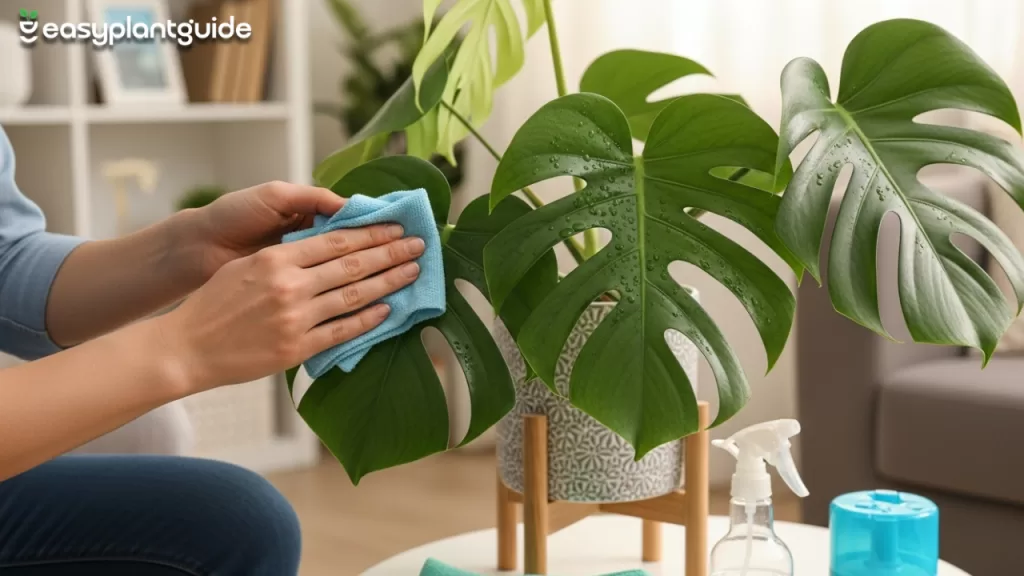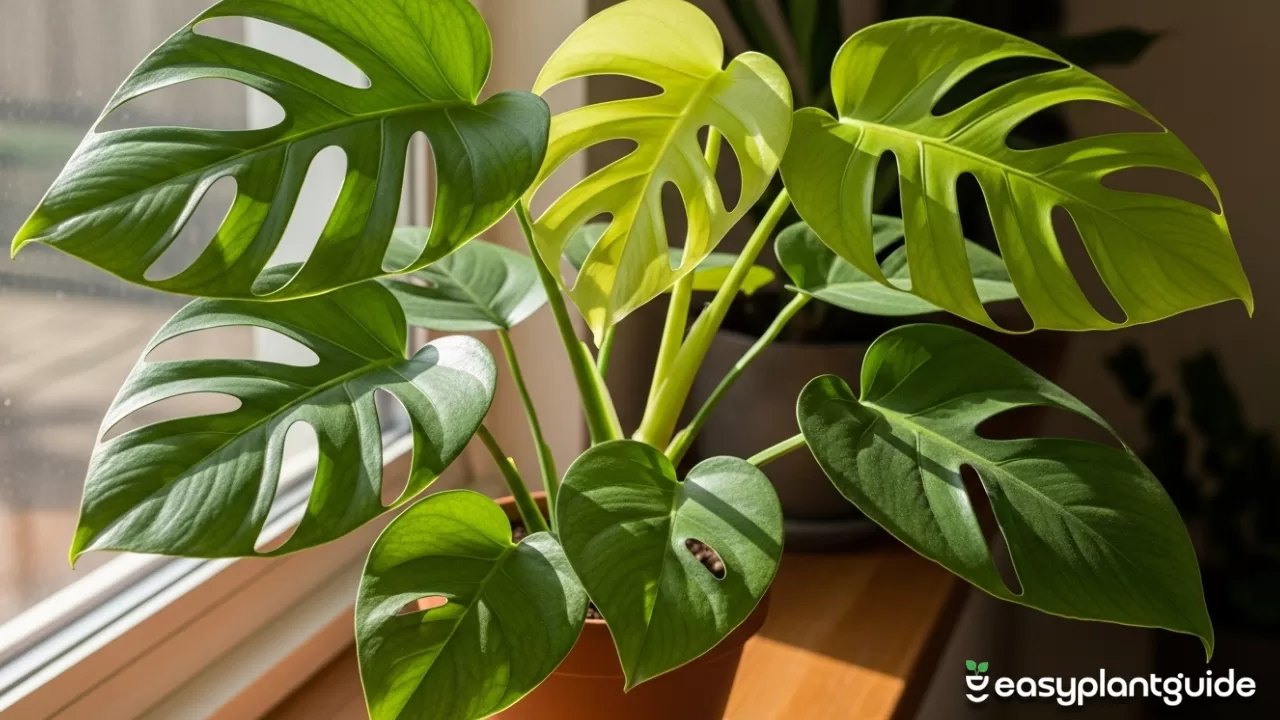Swiss Cheese Plant Care : 7 Proven Secrets
If there’s one houseplant that can instantly transform your space into a mini tropical paradise, it’s the Swiss cheese plant care — also known as Monstera deliciosa. Its glossy, hole-filled leaves give off serious jungle vibes, and its ability to thrive indoors makes it a favorite for beginners and plant experts alike. But just because it’s hardy doesn’t mean you can ignore it completely. Like every living thing, it craves a little care and attention. With the right mix of light, water, and love, your Swiss cheese plant care can grow into a lush, show-stopping masterpiece that turns every head in the room.

Understanding the Swiss Cheese Plant’s Personality
Before diving into care routines, it’s important to understand what kind of plant you’re dealing with. The Swiss cheese plant care originates from the tropical rainforests of Central America, where it climbs tall trees using its aerial roots. Those famous holes in its leaves, called fenestrations, help it absorb light even in dense jungle shade. Indoors, it loves conditions that mimic its natural home — warmth, humidity, and filtered light. When you treat it like the tropical superstar it is, you’ll see bigger leaves, stronger stems, and a plant that grows faster than you expect.
Finding the Perfect Spot – Light Makes All the Difference
Light can make or break your Monstera’s mood. This plant thrives best in bright, indirect light — similar to the dappled sunlight that filters through the rainforest canopy. Too little light makes the leaves small and dull, while too much can burn their edges. Place your plant near a window with sheer curtains to get that soft glow it adores. If your room is darker, don’t worry — a grow light can work wonders. Just remember, the more light it gets, the happier and more dramatic those iconic holes will be!
Quick Light Tips:
- Avoid direct harsh sunlight; it can scorch leaves.
- Rotate the plant weekly for even growth.
- East or west-facing windows work best.
- Clean the leaves monthly to maximize light absorption.
- Use artificial grow lights in winter months.
Watering the Right Way – Not Too Much, Not Too Little
If there’s one golden rule for Swiss cheese plant care, it’s this: overwatering kills faster than neglect. Monsteras like their soil slightly moist but never waterlogged. Always check the top two inches of soil — if they’re dry, it’s time for a drink. When watering, pour slowly until you see water drain from the bottom. Then, empty the saucer to prevent root rot. Think of watering your Monstera like making coffee — steady and measured. In winter, when the plant rests, water less frequently since the roots need less moisture to stay healthy.
Watering Reminders:
- Always use lukewarm water.
- Avoid watering on a fixed schedule; check soil first.
- Ensure proper drainage holes in the pot.
- Mist occasionally for humidity.
- Reduce watering during cold months.
The Perfect Soil Mix for a Thriving Monstera
Good soil is like a cozy home for your plant’s roots — it needs to be breathable, rich, and well-draining. Regular garden soil is too dense and can suffocate the roots. Instead, mix equal parts of potting soil, peat moss, and perlite for that fluffy texture Monsteras love. This combination holds just enough moisture while letting excess water escape easily. Adding orchid bark or coconut coir gives your plant extra aeration. When the roots can breathe, your Monstera rewards you with bigger, healthier, and more beautiful leaves every season.
Feeding Time – Fertilizer for Faster Growth
Just like we need good food, your Monstera also needs nutrients to grow strong and vibrant. During its active growing season (spring to summer), feed it every 4–6 weeks with a balanced liquid fertilizer. This helps the plant produce those iconic split leaves. In winter, cut back on feeding since growth naturally slows down. Overfertilizing can harm the roots, so less is often more. Organic options like compost tea or seaweed extract are gentle and effective choices that keep your Monstera nourished naturally.
Humidity and Temperature – The Tropical Touch
Since Monsteras come from humid jungles, they thrive in moisture-rich air. If your home feels dry, your plant will show it — leaves turn brown at the edges or droop. The sweet spot is around 60–80% humidity. You can achieve this by misting the leaves regularly, placing a humidifier nearby, or grouping plants together to create a mini humidity zone. As for temperature, keep it between 18–27°C (65–80°F). Avoid cold drafts or heaters, which can cause leaf damage and stress your Monstera out.
Pruning for Perfection – Shaping Your Monstera
Think of pruning as giving your Monstera a spa day. Removing yellow, dead, or damaged leaves not only keeps it looking neat but also redirects energy toward new growth. If your plant is getting too large or wild, trim the stems just above a node (where leaves grow). This encourages bushier growth instead of a tall, leggy look. Always use sharp, clean scissors to prevent infections. With regular pruning, you’ll keep your Swiss cheese plant care looking bold, balanced, and absolutely gorgeous all year round.
Pruning Tips:
- Cut above leaf nodes for faster regrowth.
- Use sterilized tools.
- Remove yellowing leaves promptly.
- Train stems using a moss pole.
- Don’t over-prune; leave some mature leaves intact.
Repotting – Giving Your Plant Room to Grow
As your Monstera grows, its roots eventually outgrow the pot, leading to stunted growth. That’s your cue to repot! Usually, every 1–2 years is perfect. Choose a pot that’s about 2 inches larger in diameter than the current one. Gently remove the plant, shake off old soil, and inspect the roots. Trim any that look mushy or tangled before replanting in fresh soil. Repotting not only provides more space but also refreshes the soil nutrients, giving your Monstera a healthy boost to grow bigger and stronger.
Common Problems and Easy Fixes
Even the healthiest Monsteras face a few hiccups. Brown tips often mean low humidity or too much fertilizer. Yellow leaves signal overwatering, while droopy ones could mean the opposite — it’s thirsty! Tiny holes or spots might come from pests like spider mites. Don’t panic; wipe leaves with a damp cloth and use insecticidal soap if needed. Keeping a consistent care routine prevents most problems. With a bit of observation, you’ll learn to read your plant’s “language” and fix issues before they get serious.
Swiss Cheese Plant care Quick Care Guide
| Aspect | Ideal Condition | Common Mistake | Quick Fix |
| Light | Bright, indirect light | Too much direct sun | Move to filtered light |
| Water | When top 2 inches dry | Overwatering | Check soil before watering |
| Soil | Well-draining mix | Compact soil | Add perlite or bark |
| Humidity | 60–80% | Too dry | Mist or use humidifier |
| Fertilizer | Every 4–6 weeks | Overfeeding | Use diluted fertilizer |
Propagation – Growing More from One Plant
Want more Monsteras without spending extra? Propagation is the trick! Simply cut a stem with at least one node and an aerial root. Place it in water or moist soil, and within weeks, roots will appear. Keep it in a warm, bright spot, and watch your new plant baby grow. It’s an easy, rewarding process that also makes great gifts for fellow plant lovers. Soon, your single Monstera can multiply into a whole family of green beauties ready to brighten up every corner.
Supporting Growth – Why a Moss Pole Helps
swiss cheese plant care are natural climbers, and adding a moss pole gives them the support they crave. As they grow, their aerial roots latch onto the moss, helping the plant stand taller and develop larger leaves. You can make your own pole using a bamboo stick wrapped with sphagnum moss. Keep it moist, and your Monstera will climb like it’s back in its rainforest home. The difference in leaf size and shape after training on a pole is truly impressive — a must for serious plant lovers.
Cleaning and Maintenance – Keeping It Shiny and Healthy

Dust buildup on the leaves can block sunlight and slow photosynthesis. Every few weeks, gently wipe the leaves with a damp cloth to keep them glossy. You can also shower the plant with lukewarm water for a natural cleanse. Avoid using leaf shine sprays — they can clog the pores (stomata). Regular cleaning not only keeps your plant attractive but also reduces pest problems. Think of it as giving your Monstera a breath of fresh air and a well-deserved self-care session.
Conclusion
Caring for a Swiss cheese plant care isn’t just about watering and light — it’s about creating a small tropical world where it can thrive. When you understand its natural rhythm, the plant rewards you with breathtaking growth and glossy, split leaves that capture everyone’s attention. So, give it the right care, talk to it (yes, plants love that!), and enjoy watching it grow into a statement piece in your home. With a little consistency and love, your Monstera will remain the queen of your indoor jungle for years to come.
Checkout for more blogs here.




